 Previous Article
Previous Article
Ultimate Guide For Type Composite Decking
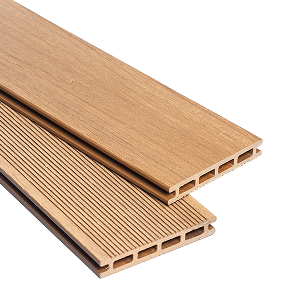
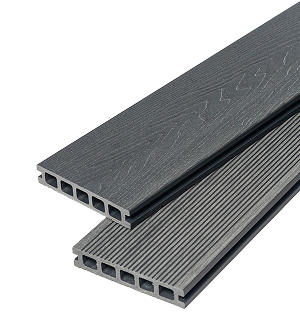
Choosing the right fastener is one of the most critical decisions for building a long-lasting, professional-looking deck. The method you use will affect your deck’s final appearance, its durability, and even how easy it is to make repairs in the future.
In this article, we’ll walk you through the pros and cons of nails, screws, and modern hidden fasteners to help you make the right choice for your project.
Choosing the right way to fix your boards is just as important as choosing the boards themselves. To help you decide, here’s a quick comparison of the main fastening methods used for decking in the UK.
| Products | Decking Nails | Screws (Face-Fixing) |
Hidden Fasteners (Clips)
|
|---|---|---|---|
|
|

|
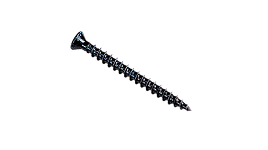
|
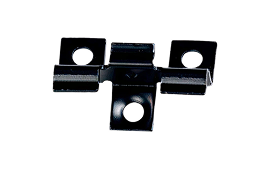
|
| Primary Use | Structural Subframe & Traditional Timber Decking | Solid Composite Boards & TimberBoards | All Grooved Composite Decking |
| Aesthetics | Visible heads can look rustic | Visible heads; can be countersunk for a flush finish. | Completely invisible a seamless, modern finish. |
| Holding Power | Good (but can pop out over time as wood moves). | Excellent grip strength. | Excellent (securely locks the board in place). |
| Our Verdict | Essential for the frame, but not recommended for fixing deck boards. | A good option for solid boards but requires pre-drilling. | The best choice for all our compositedecking boards. |
Our Expert Recommendation: While nails are crucial for building the subframe, for securing the actual decking boards to the frame, we strongly recommend hidden fasteners. They provide a far enhanced aesthetic, increased safety (no raised heads), and a more secure, long-lasting finish for your composite decking.
For modern composite decking, the best practice is to use a hidden fastener system. However, its important to understand all the options.
Exceptional Durability: Nails have excellent shear strength, meaning they can bend under pressure without snapping. This makes them suitable for structural parts of the subframe, like attaching joist hangers.
Poor Grip: They have poor grip strength. Over time, as boards expand and contract, nails can work themselves loose and pop up, creating a snagging and safety hazard. They also leave a visible head on the deck surface.
Decking Screws & Hidden Fasteners
For fixing the in particular composite deck boards, you have two modern options: a hidden fastener system or screwing directly through the face of the board.
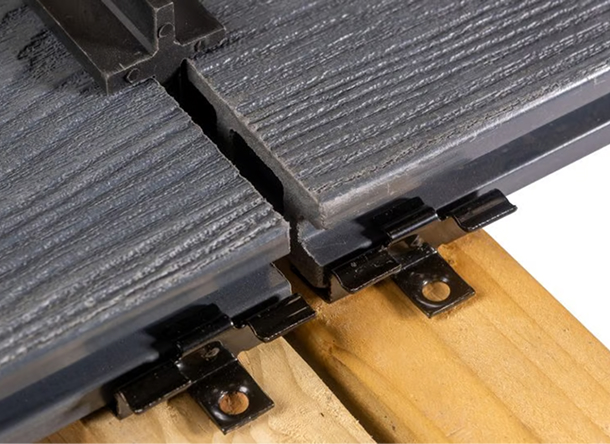
The best practice for a professional finish is to use a hidden fastening system. These are clips (like our Ultra-Clip) that fit into the side groove of the decking board and are then screwed into the joist
There are no visible screw heads on your deck, providing a clean, high-end look
This method doesn’t puncture the top surface of the board, maintaining its protective layer.
With certain plastic T-Clips, a single damaged board can often be replaced without ripping up the rest of the deck.
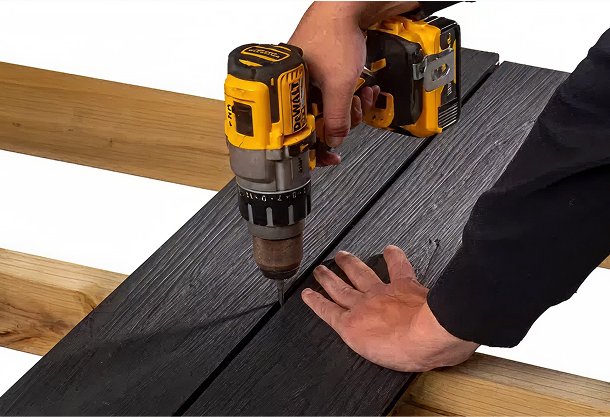
You should NEVER screw directly through the face of hollow composite decking boards. This will compromise their internal structure and can lead to the board cracking or splitting over time.
If you choose to screw directly through the face of a solid composite board, you must use specialist composite decking screws. These are designed to prevent damage and typically feature:
Even with the best installation, you may one day need to make a repair. Here’s how to tackle the most common issues.

If a screw head becomes damaged, making it impossible to remove with a drill, here are three methods to try:
If the screw head is raised even slightly, firmly grip it with a pair of locking pliers or vice grips and slowly turn counter-clockwise to back the screw out.
Place a thick rubber band over the stripped screw head. Press your drill bit firmly into the rubber band and drill slowly in reverse. The rubber can often fill the gaps and give the bit the extra grip it needs to remove the screw.
A screw extractor set is a specialist tool designed for this job. One end drills a new hole into the damaged screw head, and the other end has a reverse thread that bites into that new hole to pull the screw out.

The method depends on the type of clip used.
: In many cases, the screw head is accessible in the gap between the boards. You can use a drill with a long bit to reverse the screws on both sides of the board and simply lift it out.
With these clips, the screw is often hidden under the next board. The most common professional method is to carefully cut the damaged board out. Set your circular saw blade to the exact thickness of your decking board to avoid cutting the joist. Make two parallel cuts down the length of the board, remove the centrepiece with a pry bar, and then remove the two remaining edge pieces from the clips.
Choosing the right decking for your new project is important, but don’t skip choosing the right fastening system, as this plays a critical role in the deck’s lifespan and overall appearance. For the best visual and long-lasting performance, our recommendation will always be to use hidden fasteners with any composite decking board.
 Previous Article
Previous Article
Ultimate Guide For Type Composite Decking

Which Outdoor Material is the Best?